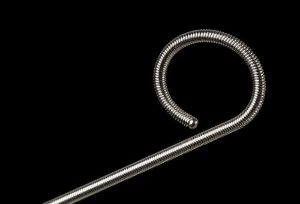Jun 2 2010
A 29-month clinical study1 demonstrated the long-term success of Cook Medical’s Resonance® Metallic Ureteral Stent in providing drainage for patients with both benign and malignant upper urinary tract obstructions, according to results presented today at the 2010 Annual Meeting of the American Urological Association (AUA). The findings suggest that metallic stents provide adequate drainage and can be maintained in situ for 12 months without significant encrustation.
 New Study Shows Metallic Stent Gives Long-Term Relief from Ureteral Blockage.
New Study Shows Metallic Stent Gives Long-Term Relief from Ureteral Blockage.
Ureteral obstruction occurs when benign or malignant growths compress sections of the urinary tract, limiting the kidney’s ability to drain properly. Malignant growths and benign obstructions can be managed with stents that hold open the blocked sections. Traditional polymer stents may need to be changed three to four times a year, exposing patients to procedural risks and the financial burden of multiple hospital visits.
“We found that the Cook stent was highly effective for 12 months in providing drainage for patients with both benign and malignant obstructions with good patient tolerance and without significant encrustation,” said Thomas Turk, M.D., lead investigator of the study and associate professor of urology at Loyola University Health System. “The Cook stent also reduced the number of replacement procedures required, due to the fact that metallic stents can be maintained in situ for 12 months without significant encrustation. For these reasons, the Resonance stent can be considered for patients requiring long-term upper urinary tract drainage.”
Dr. Turk’s team evaluated 12-month outcomes for 19 patients in all who received stent placements between July 2007 and November 2009. Of these, 13 patients suffered from benign obstructions and six from malignant obstructions. The Cook Resonance Metallic Ureteral Stent achieved and maintained adequate urinary drainage in an average of 84 percent of patients: 92 percent of those with benign obstructions, and 83 percent of those with malignant obstructions. There were no cases of stent migration, intraoperative complications or significant encrustation upon stent exchange at one year.
“Dr. Turk’s study reinforces the positive impact of the Cook Resonance Stent in providing drainage for patients with ureteral obstructions,” said Nicky James, vice president and global leader of Cook Urology. “The results of this study show that this device both improves patient care and can reduce medical costs associated with multiple stent changes.”